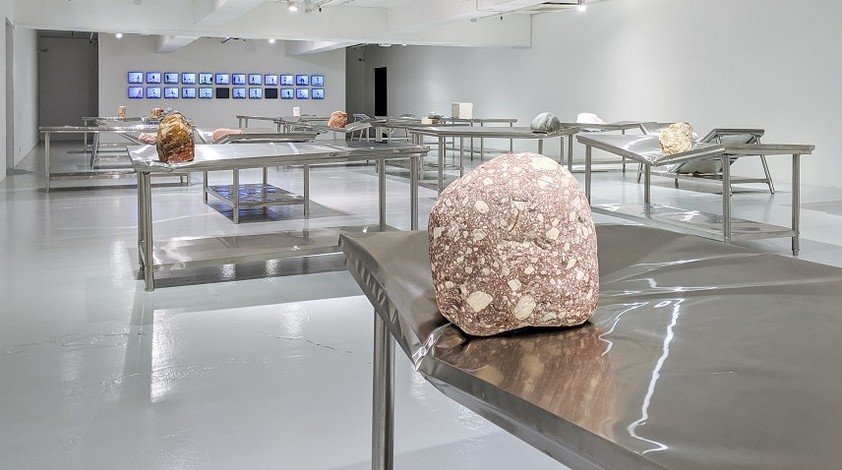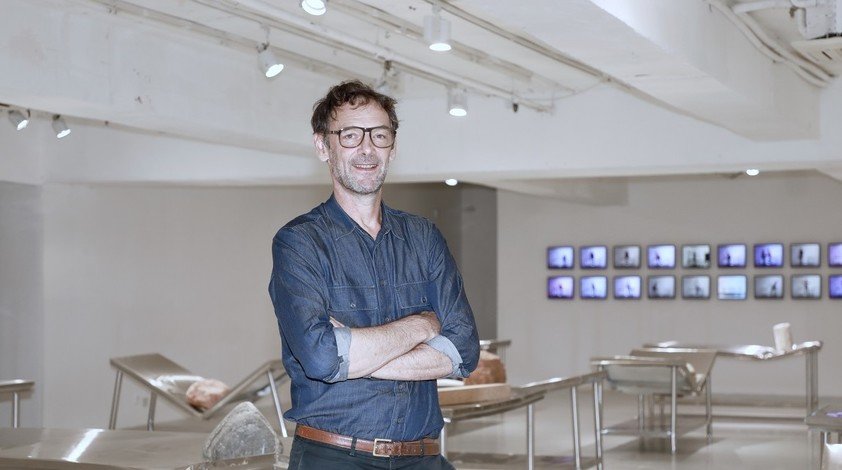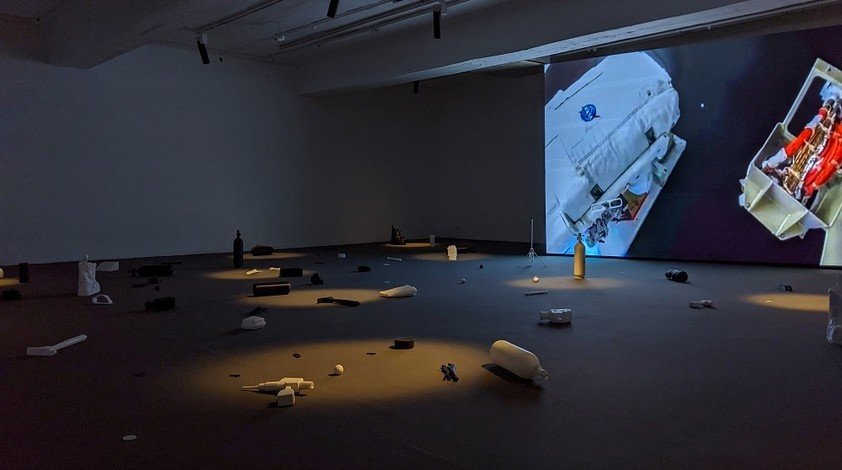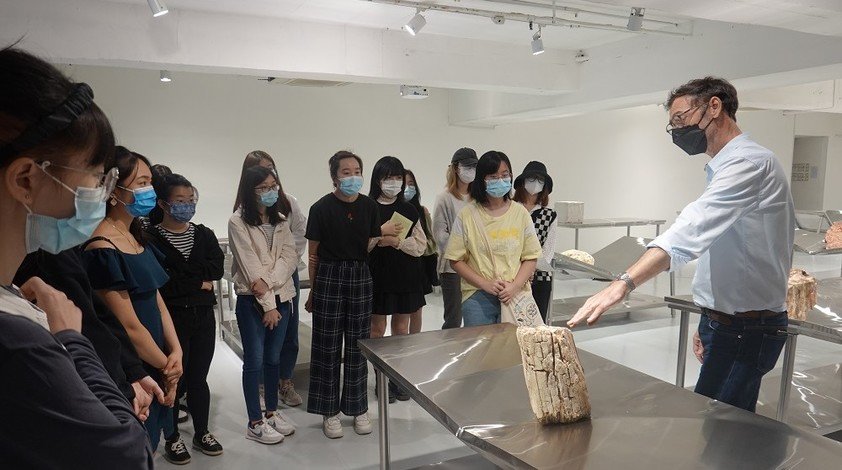discover hkbu
Dropped: Exploring our impact on space through sculpture and film
29 Oct 2021
"I've always been interested in the idea of space," says Professor Louis Nixon. "Only around 560 people have ever been, and while I'll never go, I'm trying to understand the vastness of the loneliness, the blackness of it."
For the Director of the Academy of Visual Arts, this fascination with space led to a current exhibition called Dropped, which is the culmination of six years of research and work. From a 3D-printed spanner to footage of items in space and the impact of different rocks on metal tables, the associated artworks explore through sculpture and film how objects behave under the influence of gravity, both in space and on earth, and how they drift, float and fall.
Yet while the end result is currently being displayed in an art gallery in Hong Kong, the origins of the project can be traced back to the UK and a grant from the European Space Agency (ESA).
The lure of outer space
In 2015, the ESA put out a call for artists to work on projects related to space. Professor Nixon was working at the Kingston School of Art in the UK when he applied for funding to kickstart the project.
"Space is something I've explored throughout my career. As a postgraduate sculpture student, I made a telescope with a six-inch mirror, and then following the ESA call I developed the concept of working with objects that have been dropped during spaceflight," says Professor Nixon.
Following the move to Hong Kong and HKBU in 2018, he continued the project with some funding from the Research Grants Council's General Research Fund, and this led to further research in terms of building a collection of objects that exist in space.
From trips to the Science Museum in the UK, to trawling through hours of archived mission footage and recordings of astronauts, the project has been a labour of love that has crossed the globe, as well as capturing what's orbiting above us at speeds of around 17,000 miles per hour.
Space exploration
The exhibition is being held in Osage, an art gallery tucked away off a bustling side street full of industrial buildings and busy garages in Kwun Tong, between 30 September and 11 December. You wouldn't necessarily stumble upon Osage, but once you pass through a carpark and up into the lift past the signs for gym equipment and food companies, you come to the fourth floor and the space itself.
Once inside the gallery, Dropped takes people on a tour from dark to light, and back again. Starting with a whirring 3D printer and LED TV in the dimly-lit entrance, visitors are then led to a cavernous white space housing 24 gleaming stainless-steel tables, aka Table Series 1-24 (2021).
In a city famous for its small places, visitors can walk around this expansive former industrial space and explore the different indentations made by the impact of these rocks. The colours, shapes and textures all change, as does the nature of the collisions. There is, however, one exception, and one table that has been spared with a rough-hewn block of marble neatly placed in one corner.
"The big problem in sculpture is gravity, but gravity is much weaker in space and anything is possible as you don't have to organise materials in the same way. I've worked with rocks for a long time as a sculptor. They are some of the earliest objects in the universe, and this piece explores the role of gravity on earth," says Professor Nixon.
Two neat rows of 24 mini-television screens also accompany the tables in the gallery, and each one shows in slow motion the descent of the rock and its crash into the table below, as gravity takes hold and pulls it back towards earth. The films for Table Series 1-24 also showcase Professor Nixon's various emotions, ranging from amazement to shock, and the latter is completely understandable when you see how one rock has pierced the metal table.
Visualising issues through art
It is off this main space that the rest of Dropped takes place. At opposite ends, visitors can watch two films – namely Off-earth (2015-2021) and Drifting (2021). Off-earth explores the human presence in space through objects that people have accidentally dropped or deliberately placed in space. These items, ranging from a single astronaut’s boot to a golf ball and a family photograph, spin slowly on a pitch-black background, and they are accompanied by the audio from the 12-inch golden record that was carried by the Voyager mission to portray the diversity of life and culture on earth in the event it came into alien hands.
"Art helps people visualise and learn about a set of problems, as hopefully through art we can make these issues more engaging. In particular, I became very interested in the idea that the pristineness of space has been disrupted by humans, and the way that humans have treated space. For example, going up onto the moon and just throwing stuff around and hitting golf balls seemed to me to be a sad reflection of humanity," says Professor Nixon.
The interplay of art and technology is also a thread that runs through the whole exhibition, whether it's the aforementioned 3D printer and the resultant objects, or the LED screens and slow-motion cameras used to capture some of the possessions.
In one side room, a computer screen also links through to the project website and a catalogue of items. Here, people can scroll through and view various datasets of orbiting objects and satellites.
The chaos above us
Housed at the start of the exhibition, Re-materialiser (2021) is a real-time interactive 3D map of space debris objects in the earth's orbit. The objects are clustered tightly around the earth like a ball of string, and in many ways, it's hard to imagine how we can possibly escape into space without colliding with another entity. It's these themes that Professor Nixon also wants the audience to think about and explore.
"I'm also trying to draw attention to the problem of space debris and issues such as the Kessler effect, which is a chain reaction of debris where everything becomes chaotic, and you can't actually get out into orbit. A lot of people are looking at ways in which they can clear up the mess in space, and when you see the pollution up there it really focuses the mind on what humans are doing to their environment," he says.
Some of the orbiting objects have also been re-created using 3D print technology and "teleported" back to the gallery space during the exhibition, and they populate the floor in front of the final part of the exhibition, Drifting (2021).
The piece brings together all the available film footage of objects dropped, thrown or detached in space, with the 3D printed objects below providing an ever-evolving picture of space debris that changes each day as new objects are produced by the 3D printer in the entrance.
Art-tech initiatives
As for the future, Professor Nixon remains interested in the relationship between art and technology, as well as new and old technologies, and he is also one of the co-principal investigators of the "Building Platform Technologies for Symbiotic Creativity in Hong Kong" project.
The landmark initiative aims to harness the power of science and technology to advance human and artificial intelligence interaction in art creation, and it promises to welcome in an exciting new era of art-tech in Hong Kong.
As for Dropped, Professor Nixon is looking to exhibit the show elsewhere and get more people to think about space and what these objects reveal about us and our attitudes. He is also giving a talk at a screening of Off-earth at the Hong Kong Space Museum on Saturday 6 November between 3pm and 4:15pm.
"We can find out a lot about ourselves by looking at things through the lens of space debris or a set of objects," he says. "Hopefully this will raise awareness and educate people about what is going on in space, as I think it’s important for the future."



